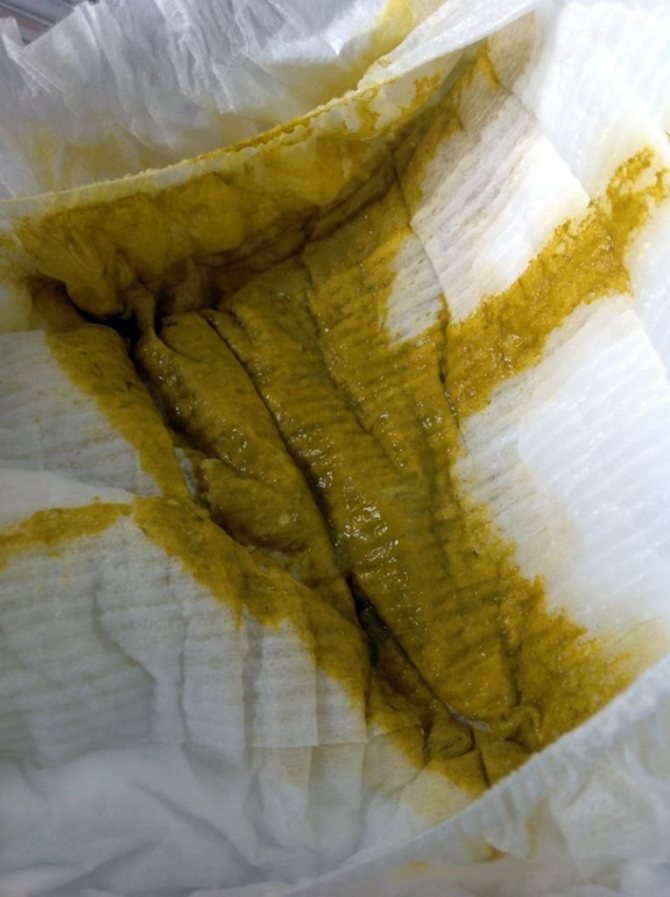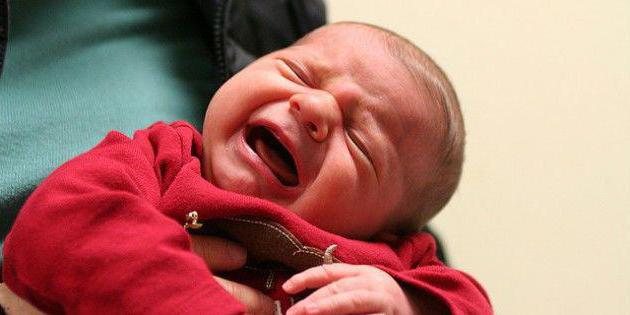Green poop in a baby can be the result of various reasons, including those that do not harm his health. However, when green stool appears, it is important to pay attention to factors such as stool consistency, frequency of bowel movements, odor, and the presence of impurities.
If you have any doubts about the child’s well-being, you should urgently seek advice from a specialist, since this symptom may also mean the presence of pathology in the child’s body.
What kind of stool should a baby have?
The baby's stool should be yellow.
The norm is that the baby's stool is yellow in color, has a mushy consistency and a sour odor.
This usually happens in children who are bottle-fed and who regularly receive food of a stable composition.
A breastfed baby's stool may vary in color, smell, and consistency. The reason for this is the composition of breast milk, which can change under the influence of many factors:
- mother's diet;
- her psycho-emotional state
- lactation period
The baby's first stool after birth is black with greenish streaks, it is very thick and tight. This stool (meconium) is normal and should not be a cause for concern.
These are epithelial cells, mucus and amniotic fluid accumulated in the intestines of a newborn. With proper development and breastfeeding of the baby, after a few days the stool becomes liquid and turns green.
During the first two months of life, the baby can have bowel movements from three to twelve times a day, ideally after each feeding. Also, stool during this period can be an indicator of proper lactation. If the baby has not had a bowel movement for 24 hours, this may indicate that he is not receiving enough milk.
If a child does not poop for 6 days and nothing bothers him (the baby is active and cheerful), then this means that mother’s milk is completely suitable for him, is well absorbed and is digested to the maximum.
What should a normal stool look like?
At different stages of development, the baby's stool changes from a liquid, unnatural color to a fraction characteristic of each person. Parents must be sure to monitor the frequency, consistency, color and presence of odor in the child’s discharge.
First three days of life
During this period of a little person’s life, the accumulation of remnants of amniotic fluid that entered the body at birth, intestinal epithelial cells, bile, mucus, etc. occurs in his intestines. Such feces are called original feces or meconium.
The discharge has a black, dark red or olive tone, a resinous structure and is odorless. Green stool in a newborn is not due to the bacterial nature of its formation. The appearance of discharge is the first sign of normal functioning of the gastrointestinal tract.
During the first two to three days, a breastfed baby’s body completely absorbs the mother’s colostrum, so feces are not formed.
Fourth – sixth days
The baby's intestinal system is developing due to changes in the composition of the nursing mother's milk and the formation of bacteria in the digestive tract.
The process occurs in two stages:
- Transitional feces
The baby's stool has the appearance of a paste, thick sour cream, the color is predominantly yellowish, with rare splashes of green (residual effects of meconium). The presence of a white mass and small amounts of stool with mucus in an infant is not a deviation. Changes in the appearance of feces occur under the influence of bacteria in the gastrointestinal tract.
The discharge takes on a dark green color with a transitional gray tint, and has a porridge-like consistency. Initially, the frequency of bowel movements is about ten times a day, and as you get used to breast milk, the frequency of bowel movements decreases to one or two times over three to seven days.
This is due to the complete absorption of the beneficial substances of breast milk in the infant’s gastrointestinal tract. It is necessary to strictly monitor meconium in the stool: if its presence in the stool is observed on the fifth day, you should consult a doctor. Artificial feeding can affect the structure of stool.
Second week of life – 28 days
The baby's stool takes on a light brown, mustard color. The consistency of the mass is mushy. Green, liquid stool in a baby or constipation indicate the occurrence of abnormalities.
First months
At the stage of feeding the baby with breast milk, the stool is normally mature. The waste products of a baby can be light brown, grayish and even green. The feces of a month-old baby on breastfeeding should be of medium density: neither liquid nor solid.
At 3 years of age, the presence of food inclusions in the stool is allowed, and the color directly depends on the food the child eats.

Causes of green poop in babies
During the period when teeth are being cut, there may be greenness in the stool.
Green poop in a baby can be considered normal. If your baby drinks only breast milk, the following factors can affect the greenness of the stool:
- The child’s body, in this way, gets rid of bilirubin;
- after being exposed to open air, feces oxidize;
- there are hormones in the stool that reach the baby through breast milk;
- green poop appears with the development of viral infections;
- the appearance of green poop at the age of 1 month indicates that the child’s body has not yet developed enough beneficial bacteria;
- the development of dysbacteriosis is accompanied by a pungent putrefactive odor.
- the child feeds only on liquid front milk, and cannot reach the hind (fat) milk, which gives color to the stool;
- During the period when teeth are being cut, intestinal dysfunction occurs, which can cause green stools for a short time.
Read: Green feces in babies as a symptom of dysbiosis?
The child began to be fed foods with which his intestines were not yet familiar. For some time, until adaptation has passed, how can it be green. Typically, the color of stool depends on what the baby eats along with breast milk. Green poop may appear due to:
- Mom ate little milk and a lot of greens (broccoli, dill, parsley, lettuce);
- Mom ate a lot of carbohydrates;
- the mother suffers from food poisoning, toxins that enter the child’s body through breast milk affect the color of the stool;
Green stool in formula-fed babies can occur if the baby is given a formula containing iron. The formula needs to be replaced and everything should be back to normal soon. Very often, baby poop turns green for no specific reason. If your baby is active and there are no other signs of pain, then there is no need to worry.
Thematic video will tell you about the baby’s stool:
Green stool in a child after one year
Allergies provoke green stools.
Green stool in a child, no matter what age, should always have a logical explanation for its origin.
If in the first months of life he speaks of disturbances in the digestive system, then in children after 1 year of age he speaks of the presence of infections. Other factors that can cause green stools:
- congenital pathologies of the digestive tract;
- development of infections;
- disruption of the immune or endocrine system;
- staphylococcal infection
- presence of intestinal parasites;
- taking certain medications
- allergy.
In any case, if the color of the stool changes, you need to be examined by a doctor and take tests to diagnose the disease and prescribe surgical treatment.
When to worry
A high temperature is a sign that the baby is not feeling well.
Determining on your own why the color of a child’s stool has changed to green is not easy.
Read: Mucus in baby’s stool: normal or pathological
Therefore, parents need to be especially careful, monitor the slightest physiological changes in the baby and, if necessary, seek medical help.
If, in addition to green stools, the child is lethargic, capricious, refuses to eat, or has a fever, then these symptoms indicate that he feels unwell. Signs requiring immediate medical attention:
- the baby has loose, foamy stools with a putrid odor;
- blood is observed in the stool;
- the appearance of green mucus in the stool;
- liquid green stool with frequent urge to defecate;
- The child does not behave calmly: he cries, writhes his legs, refuses to eat, cannot sleep, and burps frequently and a lot.
Blood, mucus and an unpleasant odor are alarming symptoms that require immediate consultation with a pediatric gastroenterologist. If necessary, to make a correct diagnosis and proper treatment, you will need to do a stool coprogram.
When is gray stool normal in a child?
Very often, gray feces in a child are considered normal, this is especially true when it comes to young children. So, in a toddler under 1 year of age, feces can be of any color. This is explained by the reaction of the child’s body to new products or a change in infant formula.
For example, when undiluted cow's milk is introduced into the diet, feces often become gray or have a silvery tint. But dirty gray stool with the putrid smell of missing hard cheese indicates that protein foods predominate in the baby’s diet. This means that the baby needs to be given more fiber, vitamins and carbohydrates.
As for grains, clots, lumps or gray flakes, these are particles of undigested food, the appearance of which is caused by the crumbs’ enzymatic system that has not yet formed. In addition, if your baby takes medications containing iron, his stool will certainly be dark gray, perhaps even black. And this should not scare parents at all and be the reason for stopping vitamins.
Taking certain medications can also cause changes in the color of stool in a child of any age. Such drugs include paracetomol, ibuprofen and augmentin. Thus, the causes of gray stool in children may be:
- age up to 1 year;
- changes in diet;
- taking honey drugs.
In these cases, the color of bowel movements always returns to normal after stopping medications, adjusting the children's menu, or after celebrating the first birthday.
What does green diarrhea mean?
Dysbacteriosis is the cause of diarrhea.
If an infant has loose green stools for several days, and the baby is lethargic and restless, then this may be diarrhea, which has developed due to the following reasons:
- Intestinal infection. Occurs under the influence of E. coli, various microbes, dysentery, paratyphoid microorganisms. The first sign is a high temperature. The baby behaves restlessly, often burps, refuses food, and loose stools appear.
- Dysbacteriosis. The most common diagnosis is the gastrointestinal tract. This develops as a result of a disturbance in the composition of the microflora, which leads to malfunctions of the digestive system. In addition to green diarrhea, the child experiences bloating, colic, and skin rashes. The specialist prescribes various types of lactic bacteria and yeast.
- Viral infection. Due to the fact that the child’s immune system is not yet developed, it depends on the state of the intestinal microflora. Therefore, green diarrhea can develop from a viral infection, or even from a simple cold.
- Allergy. Mothers can be triggered by diet, changing formula, or medications. Also, when antibiotics are prescribed, diarrhea is inevitable in most cases.
Read: White mucus in stool: symptoms and danger signs, possible diseases
Diarrhea and green stool
Is green poop (for a one-year-old child) accompanied by profuse diarrhea beyond the norm? In this case, the reasons for this stool color may be:
- Dysbacteriosis. With this diagnosis, in addition to green stool, the baby may experience bloating, colic, skin rashes, and redness around the anus. As a rule, in such cases, the baby is prescribed probiotics, that is, a group of beneficial microorganisms in the form of lactic bacteria and yeast.
- Intestinal infection. The causative agents of this disease can be bacteria, viruses, microbes and fungi. In acute forms of the disease, the baby may have a fever, anxiety, vomiting, colic, lethargy and refusal to eat.
- Viral infection. The child's immune system is immature. It is in the formative stage, and also depends on the state of the intestinal microflora. If a baby sucks breast milk, then he is almost completely protected from viral infection. As for artificial infants, in this regard it is more difficult for them.
- Allergy. Changes in the color of the baby's stool may depend on the mother's diet, changing the formula, or taking medications.

If your baby has green stool and diarrhea at the same time, you should immediately consult a doctor. After all, this phenomenon poses a particular danger to the child.
What to do if you have green stools
A stool analysis will show the state of the child’s intestinal microflora.
It is important for parents to know what to do when their child has green stool. Having an idea of what could have caused it, you can provide timely assistance to prevent serious consequences.
If there is confidence that this problem could not have been caused by the introduction of complementary foods or an incorrectly selected mixture, it is necessary to undergo a series of laboratory tests to establish the true cause of the pathology.
The analysis will require the baby's stool. Using laboratory tests, and taking into account the smell, consistency, and presence of impurities, the state of the child’s intestinal microflora is revealed. Based on the test results, the necessary treatment is prescribed. Attempts at self-medication, especially in children under 1 year of age, are fraught with serious consequences.
If dysbiosis is diagnosed in the baby, the doctor prescribes prebiotics. For more severe pathologies of the intestinal tract or the presence of infection, treatment takes place in a hospital under the supervision of specialists. If a child has green poop, and no other signs or deviations in behavior are observed, then the parents are able to eliminate this problem themselves. To do this, mom needs to do:
- Normalize breast nutrition. Make sure that the baby is fully fed with fore and hind milk. If the food is artificial, change the milk formula.
- If the nipples have an irregular shape, then you need to use special covers.
- Minimize until the condition stabilizes, green foods in the mother’s diet, such as greens, apples, salad.
- Try not to use synthetic drugs.
- If there is no idea why the feces changed color, then you need to wait a day and observe the baby’s behavior.
- If no other symptoms are observed, then this phenomenon in this case is not considered dangerous.
- Make sure your child is gaining enough weight for his age. If there is enough food, then the baby should urinate at least 8 times a day.
- Do not give bifidobacteria on your own to normalize the intestinal microflora. It must be populated with enzymes and beneficial bacteria without external influence. In addition, bifido products are prescribed by a doctor only in the presence of gastrointestinal disease.
- If green liquid stool continues for 5 days, you need to contact a medical facility for research and a correct diagnosis.
Only competent balanced nutrition and regular visits will avoid many problems with the baby’s still unformed digestion.
Read along with this article:
- Green feces in infants as a symptom of dysbiosis?
- Green color of stool in children and adults: reasons...
- Green stool in a 1 year old child: how dangerous is it and what to do?
- What to do if your one-month-old baby has diarrhea? In what cases does not...
- Baby has green stool: should I start to be nervous?
- Note to mothers: normal stool in a newborn
- A collection of tips or What to do if a newborn has loose stools
- Why does a child poop often and how to help him in this case?
- Why does my baby poop mucus? Should we panic?
Causes of green diarrhea in infants
There can be a huge number of reasons why a baby may develop diarrhea, in which the stool is green. It depends on the baby’s nutrition, his age and his state of health. Some factors that provoked such a phenomenon may be the norm and should not cause anxiety in parents. Others, on the contrary, require immediate intervention from a doctor.
So, the first group of reasons contributing to the appearance of green diarrhea in infants:
- Characteristic features of the stomach during the first 10 days of a baby’s life, which explain the olive color of the baby’s stool.
- The green tint of a breastfed baby's stool in the first year of his life is explained by the baby's underdeveloped gastrointestinal tract.
- The baby's loose stool is due to the baby receiving only foremilk.
- As noted earlier, if the mother’s diet contains green foods.
- Complementary feeding of a child, in which an apple, pear or sweet porridge is included in the baby’s diet. This may cause the baby's stool to change color.
- Green diarrhea in older children, from 3 to 5 years old, may occur due to poor nutrition.
The second group of reasons that contribute to the appearance of green diarrhea in infants, which requires immediate medical intervention, include:
- dysbacteriosis due to incorrect introduction of complementary foods or infection in the intestines;
- intestinal infections, such as escherichiosis or rotavirus infection;
- dysentery;
- salmonellosis due to the inclusion of raw or incompletely processed eggs or fish in the diet.
Thus, if a mother observes the appearance of green diarrhea in her baby, then it is necessary to analyze and understand what could cause this phenomenon. And if, as a result, the mother has concerns about the baby’s health, then she must immediately seek medical help. The corresponding symptoms will help you better understand what is happening with your baby.
If there are health problems, in addition to the appearance of green diarrhea, the baby may show other signs of pathology. For this reason, it is necessary to observe the child for some time and understand whether there are any other deviations from the norm.
Thus, green diarrhea against a background of high temperature may indicate the development of dysentery or salmonellosis. Green diarrhea with foam may indicate the development of dysbiosis or infection. In turn, green diarrhea with mucus and an admixture of bloody clots serves as the basis for suspicion of the development of dysentery in the baby’s body. Green diarrhea with mucus, but without blood, also indicates the development of salmonellosis. The development of any pathology may be indicated by such signs as the smell of the baby's feces, vomiting and the general poor condition of the child.









